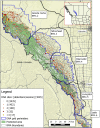Using spatial mark-recapture for conservation monitoring of grizzly bear populations in Alberta
- PMID: 29581471
- PMCID: PMC5980105
- DOI: 10.1038/s41598-018-23502-3
Using spatial mark-recapture for conservation monitoring of grizzly bear populations in Alberta
Abstract
One of the challenges in conservation is determining patterns and responses in population density and distribution as it relates to habitat and changes in anthropogenic activities. We applied spatially explicit capture recapture (SECR) methods, combined with density surface modelling from five grizzly bear (Ursus arctos) management areas (BMAs) in Alberta, Canada, to assess SECR methods and to explore factors influencing bear distribution. Here we used models of grizzly bear habitat and mortality risk to test local density associations using density surface modelling. Results demonstrated BMA-specific factors influenced density, as well as the effects of habitat and topography on detections and movements of bears. Estimates from SECR were similar to those from closed population models and telemetry data, but with similar or higher levels of precision. Habitat was most associated with areas of higher bear density in the north, whereas mortality risk was most associated (negatively) with density of bears in the south. Comparisons of the distribution of mortality risk and habitat revealed differences by BMA that in turn influenced local abundance of bears. Combining SECR methods with density surface modelling increases the resolution of mark-recapture methods by directly inferring the effect of spatial factors on regulating local densities of animals.
Conflict of interest statement
The authors declare no competing interests.
Figures









References
-
- Boulanger J, McLellan B. Closure violation in DNA-based mark-recapture estimation of grizzly bear populations. Canadian Journal of Zoology. 2001;79:642–651. doi: 10.1139/z01-020. - DOI
-
- Proctor M, et al. Ecological investigations of grizzly bears in Canada using DNA from hair: 1995–2005: a review of methods and progress. Ursus. 2010;21:169–188. doi: 10.2192/1537-6176-21.2.169. - DOI
-
- Northrup JM, Stenhouse G, Boyce MS. Agricultural lands as ecological traps for grizzly bears. Animal Conservation. 2012;15:369–377. doi: 10.1111/j.1469-1795.2012.00525.x. - DOI
-
- Nielsen SE, Boyce MS, Stenhouse G. A habitat-based framework for grizzly bear conservation in Alberta. Biological Conservation. 2006;130:217–229. doi: 10.1016/j.biocon.2005.12.016. - DOI
Publication types
MeSH terms
LinkOut - more resources
Full Text Sources
Other Literature Sources

